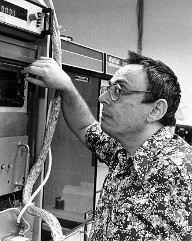-
(b.) -1931 February 19(d.)2004 February 22
Bio/Description
An American Research Professor, he was a tenured Distinguished University Professor, and Director of the Center for Automation Research at the University of Maryland in College Park, Maryland, where he also held affiliate professorships in the Departments of Computer Science, Electrical Engineering, and Psychology. He held a Ph.D. in Mathematics from Columbia University (1957), Rabbinic ordination (1952) and a Doctor of Hebrew Literature degree (1955) from Yeshiva University. He also held honorary Doctor of Technology degrees from Linkoping University, Sweden (1980) and Oulu University, Finland (1994); an honorary Doctor of Humane Letters degree from Yeshiva University (2000), and an honorary degree from the Technion (posthumously in 2004). He was a Fellow of the Association for Computing Machinery (1994). He was well known worldwide as a leading researcher in the field of computer image analysis. this contains the fields of computer or machine vision, and medical imaging, and makes heavy use of pattern recognition, digital geometry, and signal processing. The field of computer science was developed in the 1950s at academic institutions such as the Massachusetts Institute of Technology (MIT), A.I. Lab, originally as a branch of artificial intelligence and robotics. It is the quantitative or qualitative characterization of two-dimensional (2D) or three-dimensional (3D) digital images. 2D images are, for example, to be analyzed in computer vision, and 3D images in medical imaging. Over a period of nearly 40 years he made many fundamental and pioneering contributions to nearly every area of this field in that he wrote the first textbook in the field (1969); was founding editor of its first journal (1972); and was co-chairman of its first international conference (1987). He published over 30 books and over 600 book chapters and journal articles, and directed nearly 60 Ph.D. dissertations. His research on digital image analysis (specifically on digital geometry and digital topology, and on the accurate measurement of statistical features of digital images) in the 1960s and 1970s formed the foundation for a generation of industrial vision inspection systems that have found widespread applications from the automotive to the electronics industry. He was the recipient of numerous awards including: he was a founding member of the IEEE Computer Society's Technical Committee on Pattern Analysis and Machine Intelligence in 1965, and served as its Chairman from 1985 to 1987, receiving the Society's Meritorious Service Award. In addition, he received an IEEE Standards Medallion in 1990, and the Electronic Imaging International Imager of the Year Award in 1991; he received the Institute of Electrical and Electronics Engineers Emanuel Piore Award in 1985 having been a Fellow of the Institute in 1971; he was a founding member of the Governing Board of the International Association for Pattern Recognition from 1978 to 1985, serving as its President from 1980 to 1982, and won its first K.S. Fu Award in 1988; he was a founding Director of the Machine Vision Association of the Society of Manufacturing Engineers from 1985 to 1988, having won its President's Award in 1987; he was a Fellow of the Washington Academy of Sciences in 1988, and won its Mathematics and Computer Science Award, also in 1988; he was a founding Fellow of the American Association for Artificial Intelligence in 1990, and of the Association for Computing Machinery in 1993; he was a Foreign Member of the Academy of Science of the German Democratic Republic from 1988 to 1992; and he was a Corresponding Member of the National Academy of Engineering of Mexico in 1982. From 1985 to 1988 he had the distinction of serving as Chairman of a panel appointed by the National Research Council to brief the President's Science Advisor on the subject of computer vision. Also, in 1982, 1983 and from 1986 to 1988 he served as a member of a task force appointed by the Defense Science Board to review the state of the art in automatic target recognition. In 1994 he was a Harry H. Goode Memorial Award Recipient, "For fundamental contributions to the fields of pattern recognition, image processing and computer vision". He was a ba'al koreh (Torah Reader) at Young Israel Shomrai Emunah of Greater Washington for many years until he moved to Baltimore in 2001. In February 2004, he died of lung and brain cancer at the Gilchrest Center Hospice in Baltimore, Maryland. In his honor and memory, the the International Conference on Computer Vision (ICCV) gives the biennial Azriel Rosenfeld Award to a living person in the recognition of an outstanding life-time contribution to the field of image understanding or computer vision.
-
Date of Birth:
1931 February 19 -
Date of Death:
2004 February 22 -
Noted For:
Leading researcher in the world in the field of computer image analysis widely used in the fields of computer or machine vision, and medical imaging -
Category of Achievement:
-
More Info:


